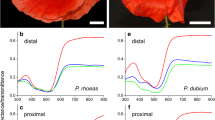Abstract
Texture such as velvet lustre contributes to the ornamental character of a flower, along with shape and colour. This study aims to clarify the relationship between the formation of the velvet lustre texture and the optical characteristics of light reflection from irradiated surfaces of velvety and non-velvety petals from 30 cultivars or varieties of ornamental plants representing 19 species from various families. The angle of incident light from the petal surface was set at 90°, 60° or 30°, then light reflection from the petal surfaces was observed using a digital microscope. The observed reflected light was composed of “exterior” reflected light (ERL), which is observed as sparkling white spots on the surface of the epidermal cells, and “interior” reflected light (IRL), which is reflected from inside the petal and determines the base colour of the petals. Velvety petals had two common characteristics: conical-papillate or domed epidermal cells and a dark colour. As the angle between the petal and the incident light decreased, the ERL spots took on a belt-like shape, and total ERL intensity became stronger. We concluded that the velvety texture is derived from characteristic ERL rays coupled with dark IRL. The long sloping surface of the epidermal cells contributes to the higher ERL intensity as petals are observed from more horizontal angles, causing characteristic reverse shading effects on velvety petals.








Similar content being viewed by others
References
Comba L, Corbet SA, Hunt H, Outram S, Parker JS, Glover BJ (2000) The role of genes influencing the corolla in pollination of Antirrhinum majus. Plant Cell Environ 23:639–647
Glover BJ, Martin C (1998) The role of petal cell shape and pigmentation in pollination success in Antirrhinum majus. Heredity 80:778–784
Gorton HL, Vogelmann TC (1996) Effects of epidermal cell shape and pigmentation on optical properties of Antirrhinum petals at visible and ultraviolet wavelengths. Plant Physiol 112:879–888
Gould KS, Marham KR, Smith RH, Goris JJ (2000) Functional role of anthocyanins in the leaves of Quintinia serrata A. Cunn. J Exp Bot 51:1107–1115
Kay QON (1988) More than the eye can see: the unexpected complexity of petal structure. Plants Today (July–August) 109–114
Kay QON, Daoud HS, Stirton CH (1981) Pigment distribution, light reflection and cell structure in petals. Bot J Linnaean Soc 83:57–84
Lu R, Koenderink JJ, Kappers AML (1998) Optical properties (bidirectional reflection distribution functions) of velvet. Appl Opt 37:5974–5984
Martin C (2002) The mechanics of cell fate determination in petals. Phil Trans R Soc Lond Ser B Biol Sci 357:809–813
Neill S, Gould KS (1999) Optical properties of leaves in relation to anthocyanin concentration and distribution. Can J Bot 77:1777–1782
Noda KI, Glover BJ, Linstead P, Martin C (1994) Flower color intensity depends on specialised cell shape controlled by a Myb-related transcription factor. Nature 396:661–664
Okamura M, Nakayama M, Umemoto N, Cano EA, Hase Y, Nishizaki Y, Sasaki N, Ozeki Y (2013) Crossbreeding of a metallic color carnation and diversification of the peculiar coloration by ion-beam irradiation. Euphytica 191:45–56
Yabuya T, Aiko Y, Adachi T (1993) Factors affecting the velvety outer perianths of Japanese Garden Iris (Iris ensata Thunb.). Cytologia 58:47–51
Yasuda H (1964) Studies on the expression of color tone in rose petals. I. Characteristic structure of the epidermis of petals in velvety dark red roses. J Fac Liberal Arts Sci Shinshu Univ 14:31–37
Zhang Y, Hayashi T, Inoue M, Hosokawa M, Oyama Y, Yazawa S (2008) Flower color diversity and its optical mechanism. Acta Horticulturae 766:469–476
Zhang Y, Hayashi T, Inoue M, Hosokawa M, Yazawa S, Li YH (2009) Metallic lustre and the optical mechanism generated from the leaf surface of Begonia rex Putz. Sci Hortic 121:213–217
Acknowledgments
We are grateful to Dr. Beth Eva Hazen for improving the English of this manuscript. This study was funded by the Fundamental Research Funds for the Central Universities (DL13CA01), the National Natural Science Foundation of China (31000318) and the China Postdoctoral Science Foundation (20090450945, 201104405).
Author information
Authors and Affiliations
Corresponding author
Rights and permissions
About this article
Cite this article
Zhang, Y., Sun, T., Xie, L. et al. Relationship between the velvet-like texture of flower petals and light reflection from epidermal cell surfaces. J Plant Res 128, 623–632 (2015). https://doi.org/10.1007/s10265-015-0725-8
Received:
Accepted:
Published:
Issue Date:
DOI: https://doi.org/10.1007/s10265-015-0725-8



